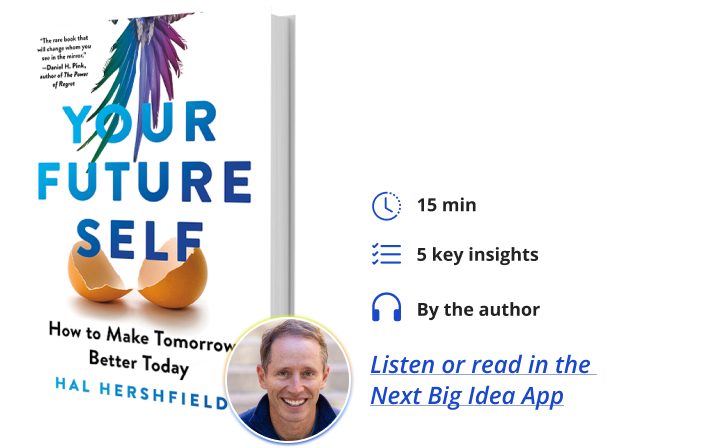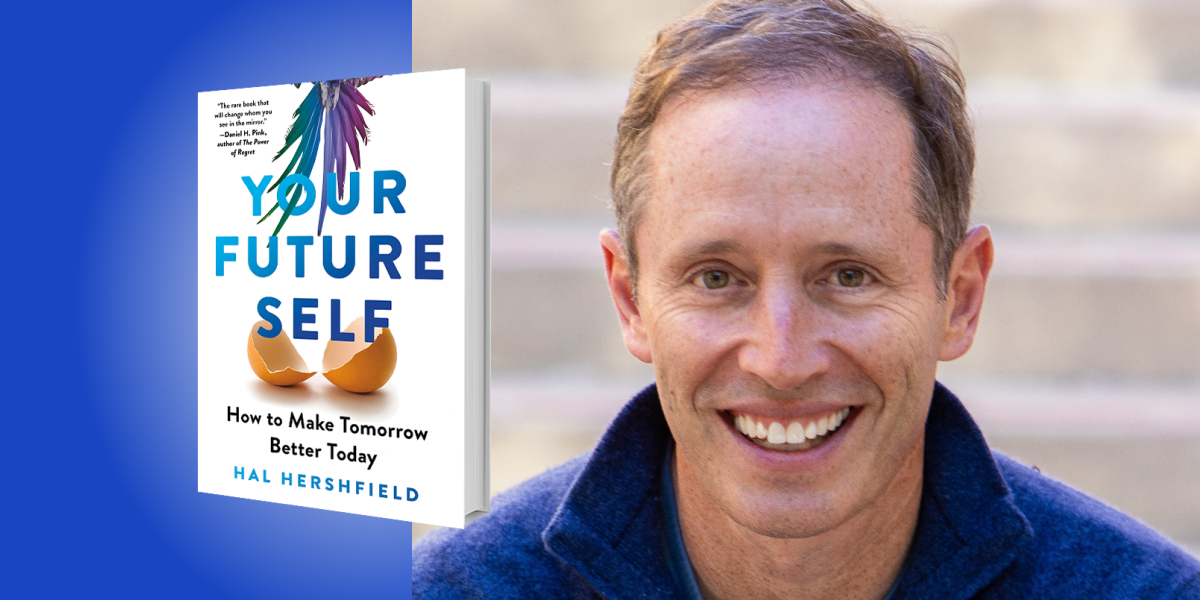Hal Hershfield is a Professor of Marketing, Behavioral Decision Making, and Psychology at UCLA’s Anderson School of Management and holds the UCLA Anderson Board of Advisors Term Chair in Management. He earned his Ph.D. in psychology from Stanford University. Hershfield publishes in top academic journals and also contributes op-eds to the New York Times, Harvard Business Review, the Wall Street Journal, and other outlets. He consults with the Consumer Financial Protection Bureau, and many financial services firms such as Fidelity, First Republic, Prudential, Morgan Stanley, Merrill Lynch, and Avantis.
Below, Hal shares five key insights from his new book, Your Future Self: How to Make Tomorrow Better Today. Listen to the audio version—read by Hal himself—in the Next Big Idea App.

1. We may think of our future selves as if they are entirely different people.
Emily Pronin, a psychology professor from Princeton, has conducted a research study where student participants were asked to describe a meal that they were eating at that moment. Most people described it through what’s known as a first-person perspective, how they saw the meal in front of them. Then the same students were asked to imagine a meal that they would eat in the distant future, sometime after they were 40 years old. In this activity, they were about four times as likely to use the third-person perspective, seeing themselves as if they were another person in the scene. What is interesting about this is that it suggests that, in our mind’s eye, our future self looks like another person.
In my own research, I have also found the same results. My colleagues and I found that by using neuroimaging methods, the brain activity that arises when we think about our future selves is more on par with the brain activity that arises when we think about another person. As an analogy, we may imagine our future selves as another person.
2. When it comes to long-term decisions, what matters is the type of relationship that we have with that future person.
There are many different ways to treat other people in our lives. When it comes to interacting with complete strangers, we might find ourselves being somewhat selfish or self-interested. It’s not that we’re bad people, we just don’t have a connection to them. If someone you didn’t know that well, like a coworker, asked you to help them move this weekend, it’s likely you’d come up with a million excuses not to help them. It doesn’t mean that you are selfish, but it does mean that in some situations, you may act in a self-interested way.
“If we think about our future selves as if they are others we are close to, then we will be more open to doing things for their benefit.”
If that is how we see our future selves, that is, if they seem like strangers to us, then it makes sense that we might not do things that benefit them—things like overeating, overspending, or undersaving. The caveat to this is that there are people in our lives whom we do act generously toward. People like our children and our parents and our closest friends and even the coworker with whom we may really connect. When it comes to long-term decisions, if we think about our future selves as if they are others we are close to, then we will be more open to doing things for their benefit.
My own research and research conducted by others has confirmed this theory. People who feel a greater sense of similarity and connection to their future selves are, for example, more likely to have accrued assets, to act ethically, to report greater subjective health, life satisfaction, and meaning in life. Those findings remain true even when you take into account other factors.
3. Try to make your future self seem closer.
One way to do this is by enhancing how vivid your future self is. Anne Napolitano, the best-selling fiction author, started writing letters to her future self when she was 14 years old. She wrote a letter to herself ten years older; and then after ten years, she read the letter and wrote a new letter to her future self.
Not only does that take an incredible amount of commitment, but she also told me in an interview that she often wanted to read the letters early, but she never did. For her, the act of writing a letter to her future self and also reading letters from her past self helped her identify the core values that she found truly important, keeping her on the right path.
“She often wanted to read the letters early, but she never did.”
One way that we can do this, according to research, is to write a letter to our future selves, and then step into the shoes of our future selves, and write a letter from them. This is an activity that can help make the future more vivid while helping us feel less anxiety in the present about all of the uncertainties that remain for the years to come.
4. Stay on course by adding constraints to our future behavior.
We can make life easier for our future selves by making grand plans now to ease our future lives. For example, eating more healthily in the evenings now will help our future selves look back and say, “I did a good job eating healthily.” However, we also have a present version of ourselves who will inevitably screw things up and snack late at night. We can counteract this by engaging in smart commitment devices.
Dave Krippendorff, a graduate student at MIT, lived across the street from a Whole Foods. He often found himself sneaking out of his house when he was faced with a difficult problem set and buying snack after snack. Over time his waist got bigger and his wallet got thinner. He wanted to figure out a way to stop this behavior so he invented a little safe with an electronic timer on top. He put the snacks inside it and locked it away for a period of time, anywhere from a minute to ten days. He took his idea to Shark Tank, won financing, and left his high-paying job to start Kitchen Safe. He’s found over the years that people use the safe for so many different things outside of kitchen snacks, that he has rebranded it kSafe.
“I use it to lock away my phone during dinner times so that I’m more present with my family.”
The beauty of this product is that it puts some constraints on our future behavior. In fact, I use it to lock away my phone during dinner times so that I’m more present with my family. Commitment devices can be incredibly powerful. However, to adopt a commitment device, it relies on us to choose something that gives us sufficient enough punishment so that we don’t engage in an undesirable behavior, but also that doesn’t punish us so severely that our current selves fail to adopt the commitment device altogether.
5. Make present-day sacrifices feel easier to undertake.
For any of the trade-offs that exist between our current and our future selves, it’s always our current self who has to make the sacrifice and our future self who may or may not benefit from those decisions. It’s almost like being in a bad relationship where you’re the one who’s always doing things for the other person.
One way around this is to try to reframe things so that those sacrifices don’t feel so hard to undertake. During a recent research study conducted with colleagues, I worked with a fintech company to try and see if new users of its app would sign up for an automatic savings account. We asked these new users if they wanted to save $150 a month, $35 a week, or $5 a day. Four times as many people signed up for the account when it was framed as $5 a day, in part because it certainly feels like a much easier sacrifice to make. If we want to do right by our future selves, we need to come up with ways to ease the tension between our current and future selves.
To listen to the audio version read by author Hal Hershfield, download the Next Big Idea App today:






























